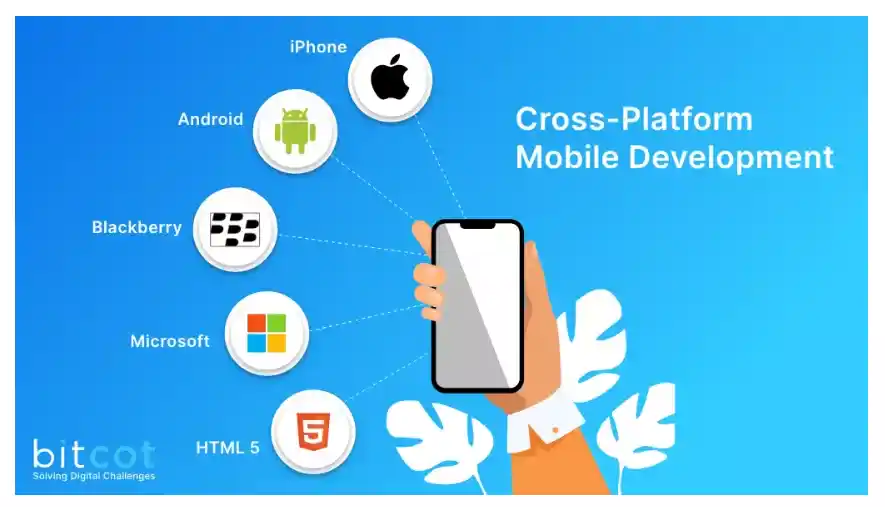Table of Contents
In 2023, Americans spent an average of 4 hours and 25 minutes daily on their smartphones, checking them 144 times each day. With millions of apps available, the mobile market is fiercely competitive. Staying updated with the latest mobile app development trends for 2024 is essential for your business’s success.
By adopting these trends, we meet the audience’s expectations. Today’s users seek seamless, innovative, and value-rich apps. Leveraging these app development trends enables businesses to make informed strategic decisions and optimize their resources more efficiently.
1. AI and ML in Mobile Application Development Trends
Integrating AI and ML is at the forefront of mobile application development trends. These technologies enable developers to create dynamic and intuitive applications by:
- Using AI to analyze extensive data and improve decision-making.
- Leveraging ML to adapt and learn from user interactions, enhancing app performance over time.
- Apps can adapt to user behavior and preferences instantly.
- Real-time analytics and automation make apps more intuitive.
- Streamlining mundane tasks improves user efficiency and satisfaction.
For instance, a fitness app can customize workout plans based on individual user histories and goals.

AI and ML in Action
Successful implementations of AI and ML in mobile application development trends include:
- Chatbots: Bank of America’s Erica assists with customer queries and financial decision-making.
- Predictive Text: Google Search refines suggestions based on user input.
- Content Personalization: Netflix and Spotify use ML algorithms to suggest content based on user preferences.
- Navigation: Google Maps uses real-time data to plan optimal routes.
Understanding and incorporating these trends can help businesses create cutting-edge apps that meet user expectations and stand out in a competitive market.
2. Augmented Reality (AR)
Augmented Reality is a leading trend in mobile application development trends, overlaying digital information onto real-world surroundings. Unlike Virtual Reality, which creates entirely virtual environments, AR enhances our actual environment. Recent advancements in computational power and camera technology have significantly improved AR’s accessibility.

AR’s Diverse Applications Across Industries
Once a futuristic concept, AR now offers innovative experiences across numerous industries:
- Retail and E-Commerce: Customers can virtually place products in their space before purchasing. Apps like IKEA Place and Amazon AR View allow users to see how furniture would look in their homes.
- Education: Learning becomes more engaging with interactive AR flashcards and 3D models integrated into textbooks.
- Travel and Tourism: AR apps provide real-time translations of signs and detailed information about landmarks. Google Translate and Google Lens offer instant translations and historical insights. A booking app with AR could allow users to experience 3D virtual tours of properties before finalizing reservations.
- Healthcare: AR facilitates remote consultations and diagnostics. The Proximie app, for example, enables remote surgical collaboration, providing real-time guidance and improving expertise transfer.
AR’s Bright Future: Expansive Possibilities
AR holds immense potential in the mobile industry, especially when integrated with AI, IoT, and blockchain. Combining AR with AI leads to more intuitive interfaces that better anticipate user needs. Significant investments from Google and Apple in AR technology, including the anticipated launch of AR glasses, signal a bright future for AR
3. Internet of Things and Enhanced Connectivity
With the rise of the Internet of Things (IoT), mobile application development trends are evolving into centralized control hubs for a multitude of devices. Imagine your smartphone as a universal remote, seamlessly controlling, monitoring, and interacting with various connected devices.
IoT in Action: Everyday Applications in Mobile Apps
Mobile apps powered by IoT now facilitate real-world interactions and predictive analytics, adding new dimensions of functionality, automation, and user engagement.

- Smart Home Applications: With platforms like Google Home and Apple’s HomeKit, users can control thermostats, lights, and security cameras directly from their smartphones.
- Health and Fitness Tracking: Devices like Fitbit and Apple Watch pair with mobile application development trends to monitor health metrics, allowing users to track heart rates, sleep patterns, and physical activity.
- Automotive Integration: Tesla owners can manage various vehicle functions through the native app, including climate control adjustments, location tracking, and door locking/unlocking.
4. Mobile Application Development Trends: The Critical Role of Security and Privacy
In today’s environment, ignoring security and privacy trends in mobile app development is simply not feasible. While new technologies bring excitement, they also introduce risks like app vulnerabilities and cyberattacks. Developers must proactively address issues such as data breaches, unauthorized access, and malware threats.

Non-compliance with these regulations can result in hefty fines and a severe erosion of user trust, potentially causing long-term damage to your brand.
5. Cross-Platform App Development
One of the leading mobile application development trends is cross-platform development. This approach allows developers to write code once and deploy it across multiple platforms, using frameworks that provide a unified API over native components.
Key Frameworks for Cross-Platform Development
- React Native: Leveraging JavaScript, this open-source framework enables the creation of mobile application development trends using React.
- Flutter: Using Dart, Flutter offers a rich set of pre-designed widgets to ensure a cohesive platform experience.
While cross-platform development can streamline the process, it’s essential to understand its pros and cons.

Benefits of Cross-Platform Development
- Cost Efficiency: Development costs are generally reduced by working with a single codebase for multiple platforms.
- Time Savings: Quicker market entry is achievable due to shortened development cycles.
- Uniform User Experience: Maintaining a consistent design and functionality across different platforms becomes simpler.
- Consistency: A single codebase ensures consistent app behavior across all platforms.
Real-World Applications of Cross-Platform Frameworks
Many corporations have successfully embraced cross-platform development, including:
- Skype: Transitioning to React Native allowed Skype to simplify its codebase and improve both performance and maintainability.
- Walmart: Adopting React Native improved the app’s performance, resulting in smoother animations and quicker load times.
Balancing Cost, Time, and Performance
Adopting cross-platform development allows businesses to reduce development time and costs. The “low code” approach enhances features instead of focusing on platform-specific customization. However, the potential impact on performance must be considered, as it can influence user experience and the app’s overall success.